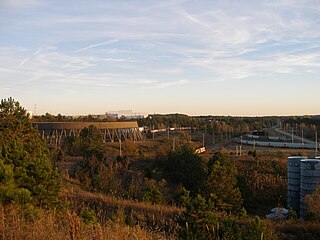
The Tennessee Valley Authority (TVA) is a federally owned electric utility corporation in the United States. TVA's service area covers all of Tennessee, portions of Alabama, Mississippi, and Kentucky, and small areas of Georgia, North Carolina, and Virginia. While owned by the federal government, TVA receives no taxpayer funding and operates similarly to a private for-profit company. It is headquartered in Knoxville, Tennessee, and is the sixth-largest power supplier and largest public utility in the country.

The Browns Ferry Nuclear Power Plant is located on the Tennessee River near Decatur and Athens, Alabama, on the north side of Wheeler Lake. The site has three General Electric boiling water reactor (BWR) nuclear generating units and is owned entirely by the Tennessee Valley Authority (TVA). With a generating capacity of nearly 3.8 gigawatts, it is the third most powerful nuclear power plant in the United States, behind the Palo Verde Nuclear Power Plant in Arizona and the Vogtle Nuclear Power Plant in Georgia, and the most powerful generating station operated by TVA.

The Sequoyah Nuclear Plant is a nuclear power plant located on 525 acres (212 ha) located 7 miles (11 km) east of Soddy-Daisy, Tennessee, and 20 miles (32 km) north of Chattanooga, abutting Chickamauga Lake, on the Tennessee River. The facility is owned and operated by the Tennessee Valley Authority (TVA).

The Watts Bar Nuclear Plant is a Tennessee Valley Authority (TVA) nuclear reactor pair used for electric power generation. It is located on a 1,770-acre (7.2 km²) site in Rhea County, Tennessee, near Spring City, between the cities of Chattanooga and Knoxville. Watts Bar supplies enough electricity for about 1,200,000 households in the Tennessee Valley.
The Alvin W. Vogtle Electric Generating Plant, also known as Plant Vogtle, is a four-unit nuclear power plant located in Burke County, near Waynesboro, Georgia, in the southeastern United States.

The South Texas Project Electric Generating Station, is a nuclear power station southwest of Bay City, Texas, United States. STP occupies a 12,200-acre (4,900 ha) site west of the Colorado River about 90 miles (140 km) southwest of Houston. It consists of two Westinghouse Pressurized Water Reactors and is cooled by a 7,000-acre (2,800 ha) reservoir, which eliminates the need for cooling towers.

Quad Cities Generating Station is a two-unit nuclear power plant located near Cordova, Illinois, United States, on the Mississippi River. The two General Electric boiling water reactors give the plant a total gross electric capacity of approximately 1,880 MW. It was named for the nearby cities of Moline, Illinois, Rock Island, Illinois, Davenport, Iowa, East Moline, Illinois, and Bettendorf, Iowa — known as the Quad Cities.
The "Nuclear Power 2010 Program" was launched in 2002 by President George W. Bush in 2002, 13 months after the beginning of his presidency, in order to restart orders for nuclear power reactors in the U.S. by providing subsidies for a handful of Generation III+ demonstration plants. The expectation was that these plants would come online by 2010, but it was not met.

The AP1000 is a nuclear power plant designed and sold by Westinghouse Electric Company. The plant is a pressurized water reactor with improved use of passive nuclear safety and many design features intended to lower its capital cost and improve its economics.

In the United States, nuclear power is provided by 92 commercial reactors with a net capacity of 94.7 gigawatts (GW), with 61 pressurized water reactors and 31 boiling water reactors. In 2019, they produced a total of 809.41 terawatt-hours of electricity, which accounted for 20% of the nation's total electric energy generation. In 2018, nuclear comprised nearly 50 percent of US emission-free energy generation.

Bull Run Fossil Plant, commonly known as Bull Run Steam Plant, is a decommissioned 889 megawatt (MW), coal-fired electric generating station owned and operated by the Tennessee Valley Authority (TVA). The plant is the only coal fired power plant ever constructed by TVA with one unit, and was retired on December 1, 2023.

The U.S. state of Tennessee contains a diverse economy that is made up of many sectors with a mix of industries including manufacturing, agriculture, healthcare, and tourism. The state is home to several major corporations, including FedEx, the largest courier company in the world, and AutoZone, the largest retailer of auto parts in the United States.

Between 2007 and 2009, 13 companies applied to the Nuclear Regulatory Commission (NRC) for construction and operating licenses to build 31 new nuclear power reactors in the United States. However, the case for widespread nuclear plant construction has been hampered due to inexpensive natural gas, slow electricity demand growth in a weak US economy, lack of financing, and safety concerns following the Fukushima nuclear accident at a plant built in the early 1970s which occurred in 2011.

Washington Nuclear Project Nos. 1 and 4, abbreviated as WNP-1 and WNP-4 were two of the five nuclear power plants on which construction was started by the Washington Public Power Supply System (WPPSS) in order to meet projected electricity demand in the Pacific Northwest. WNP-1, WNP-2 and WNP-3 were part of the original 1968 plan, with WNP-4 and WNP-5 added in the early 1970s.

The Yellow Creek Nuclear Plant is a canceled nuclear power plant project near Iuka, Mississippi. It was originally planned to have two 1,350-MW (output) reactors operated by the Tennessee Valley Authority (TVA). The steam turbine-generator sets were provided by General Electric.
The B&W mPower was a proposed small modular reactor designed by Babcock & Wilcox, and to be built by Generation mPower LLC, a joint venture of Babcock & Wilcox and Bechtel. It was a Generation III+ integral pressurized water reactor concept.

The Paradise Combined Cycle Plant is a natural gas power plant operated by the Tennessee Valley Authority (TVA). Located just east of Drakesboro, Kentucky, it was the highest power capacity power plant in Kentucky. The plant currently has a capacity of 1.02-gigawatts. The plant originally consisted of three coal units, with a combined capacity of 2,632 MW. Units 1 and 2 were retired in 2017, and replaced with the natural gas units, and Unit 3 was retired in 2020.

Phipps Bend Nuclear Plant was a planned nuclear power generation facility that was to be constructed and operated by the Tennessee Valley Authority (TVA) in unincorporated Hawkins County, Tennessee. Proposed to house two reactor units, the power plant was estimated to cost $1.6 billion when it was first planned in late 1977, provide a generating capacity of 2,600,000 kilowatts. Following negative public reactions towards nuclear energy following the Three Mile Island accident and a decreasing demand for power due to regional economic decline, the TVA's board of directors voted to defer further construction of the power plant. By 1981, the plant was 40% complete and an estimated $1.5 billion in planning, engineering, and construction costs had accumulated. Construction never resumed, and the project was canceled overall in 1982 due to lower load growth than forecast. By the project's cancellation, the TVA had amassed over $2.6 billion in spending for the incomplete nuclear facility. After being auctioned off by the TVA in 1987, the land acquired for the plant would be under the ownership of Hawkins County's industrial development board, who converted most of the site into an industrial park. A 1 MW solar farm was built at the site in 2017.

Watts Bar Steam Plant was a 267-megawatt (MW), coal power plant operated by the Tennessee Valley Authority (TVA) located in Rhea County, Tennessee near the present site of Watts Bar Nuclear Plant and Watts Bar Dam. The plant was the first coal-fired power plant constructed by TVA.




















